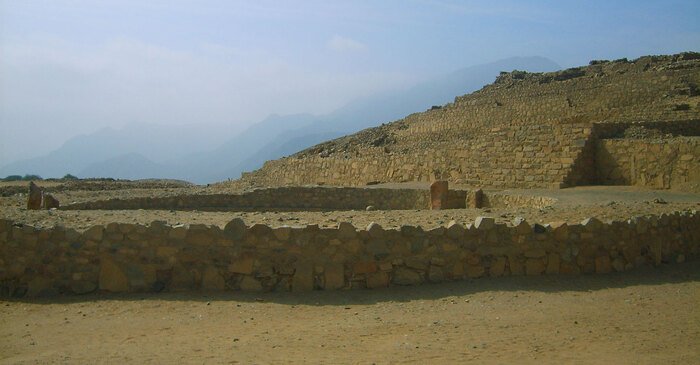Archaeologists have long believed that when the pharaoh Cheops was building the first of Egypt’s great pyramids about 4,560 years ago, the Americas were still a tribal backwater of small hunter-gatherer villages. The new finding suggests that Caral, a large city with huge pyramids of its own, may already have been decades old at the time. The startling conclusion, which could topple some theories about the origins of urban life, results from new, extremely precise radiocarbon dating of the obscure 170-acre site, which was discovered in 1905 but had never been dated or carefully studied.

Dating shows that parts of Caral, in Peru’s remote Supe valley, were built as early as 2627 B.C., which makes it about 1,000 years older than the oldest known city in the Americas. The pyramid of Cheops, the largest and earliest of the Giza pyramids in Egypt, was finished around 2560 B.C.
Caral’s center is a huge, sunken circular plaza, more than a third of a mile across, surrounded by large stepped pyramids which have crumbled around the edges so they appear now as rounded mounds. The largest is 19.81 meters high and larger than a football field. Next to the pyramids were complexes of high- status dwellings of stone with large rooms and fine plaster walls, while farther out the archaeologists uncovered areas with medium-status and lower- status residences, smaller and made of mud and cane.

The discovery will force archaeologists to rethink their theories of how civilization began in the Americas. While archaeologists used to believe that no urban centers appeared anywhere in the world until the domestication of grain made large-scale central storage of foods possible, that theory has been crumbling in recent years with the discovery of some urban sites in the Middle East and elsewhere that seem to predate grain cultivation. But this is the first site in the Americas to do so.

Caral lies in a narrow valley, about 22.5 kilometers from the coast. Rather than large-scale growing of food crops, the archaeologists said, Caral apparently had an extensive irrigation system, primarily for growing cotton and gourds. Some crops were apparently grown, including avocados, beans, peanuts and squash. Seafood, including sardines, anchovies and mussels, may have been their primary food, as indicated by remains found at the site.












